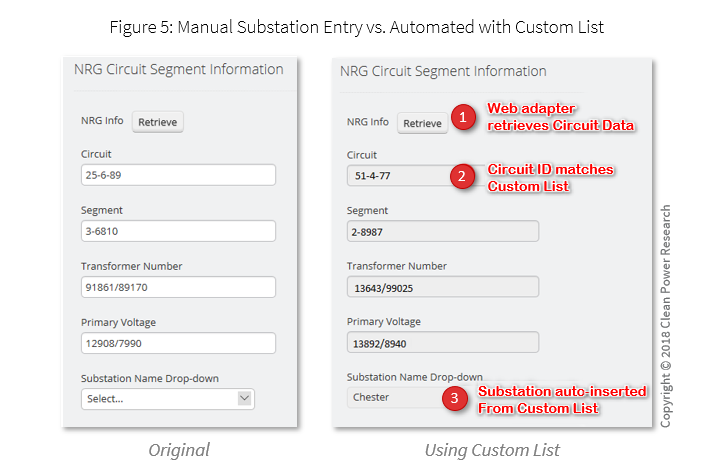The evolving landscape (and definition) of DERs leads to increasingly complex interconnection requests. Regulatory changes in states such as California and New York are resulting in new storage incentives. As a result, utilities will likely require PV interconnection applicants to also provide associated battery system specifications. Utilities that accurately capture battery specifications will have the information needed to more accurately plan for DERs, and make use of those storage systems for operational use cases in the future.
This post discusses how utilities using PowerClerk® can accurately capture information about other, non-PV DERs through Custom Lists and further automate their processing workflows—and prepare for a future of DERs.
Increasing DER data accuracy using lists
The original equipment list feature in PowerClerk is the PV System Specification field. As shown in Figure 1, this field allows applicants to select their PV System from a tiered set of list fields containing a California Energy Commission (CEC) curated list of inverters and panels.

This makes it easy for applicants to select the correct manufacturer and model, and guarantees the information will be entered in a standard format. A trusted list of hardware reduces application errors such as misnaming a piece of hardware or entering model power ratings incorrectly. This significantly cuts down on reviews and improves calculation accuracy with trusted data.
Although applicants only see the hardware make and model, PowerClerk uses the efficiency ratings for calculations that produce information important to the utility, such as annual expected energy generation. This layer of mapping (equipment make/model-to-rated efficiency) is key to ensuring that each application has comparable results.
Requiring an applicant to self-provide equipment efficiency would make it harder for installers to submit applications, as many don’t keep that type of information on hand. It would also require utilities to verify information, leading to longer processing times. Accuracy of DER data is extremely important to the utility for planning purposes.
Expanding lists to new use cases
As DER programs have been expanding, a frequent request is the ability to create custom lists that work in the same way as the PV System Spec field, but with different data. From these requests, the Custom List feature was born.
The Custom List feature allows PowerClerk admins to configure and create their own lists and upload them to PowerClerk. The Custom List can contain a tiered structure and can populate specific fields with predetermined data. That means a better presentation of choices to applicants than multiple, free form entry fields. As a result, the time needed to fill out forms is cut down, and the reduction of erroneous or incomplete data keeps the review process streamlined.
Capturing battery storage specifications
We can use Custom Lists to demonstrate the battery storage case mentioned above. To start, we created a Custom Battery Storage list in a spreadsheet as shown in Figure 2, then imported the data into PowerClerk. Each column is a field within the Custom List that PowerClerk can later use for calculations and form logic.

As shown in Figure 3, this fixed list is then made available in a form so that applicants can select data rather than manually entering information that could be inaccurate (such as battery capacity) or that is subject to typos.

Using Custom Lists to automate workflows
As we’ve described, Custom Lists work great for hardware, but applications extend well beyond hardware. For example, if a utility wants to use circuit information—pulled in via a web adapter—to identify the name of the substation for each application, they can use a Custom List to match circuits with substation names. This automated approach replaces a manual look-up of the substation name, which slows the process and introduces human error if the wrong substation is selected.
As shown in Figure 4, all that is needed is a simple two column Custom List:

Figure 5 shows how the substation name is automatically inserted based on the Circuit Prefix value provided via the web adapter:

A world of possibilities
The Custom List feature opens a world of possibilities for utilities designing DER programs. With Custom Lists, PowerClerk users can design programs that provide a great applicant experience with no repetitive or tedious data entry. Just as important, Custom Lists enable utilities to obtain all the quantitative information that’s required to run their business.
Custom lists are available right now in PowerClerk, so contact us for sample lists and get this powerful new feature working for you. With Custom Lists, you can move your PowerClerk program beyond interconnections and streamline your workflows.
